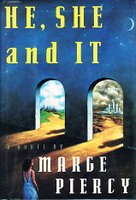We’re off for the Thanksgiving holiday. Have a good day off if you’ve got one; we’ll see you all tomorrow.
Tag Archives: Noah
He, She, and Apocalypse
This post is my first Twisted Mass of Heterotopia column, supported by my Patreon subscribers. If you think it’s the sort of thing you’d like me to write more of, consider contributing (and thank you!)
________
 Marge Piercy’s 1991 novel He, She, and It isn’t exactly a post-apocalyptic novel; her future world doesn’t end, and doesn’t necessarily seem like it’s about to in the near term. Still, there are a lot of little apocalypses scattered around in it—small scale disasters, of perhaps mildly more intensity than those you can see anytime you turn on the news. The greenhouse effect has pushed temperatures up worldwide; the sky is no longer blue, and going out into daylight without protective gear is potentially fatal. Plagues, famine, and infertility caused by toxic waste and radiation has reduced the earth’s population by half. Most dramatically, a nuclear terrorist attack and subsequent war utterly destroyed Israel and most of the Middle East.
Marge Piercy’s 1991 novel He, She, and It isn’t exactly a post-apocalyptic novel; her future world doesn’t end, and doesn’t necessarily seem like it’s about to in the near term. Still, there are a lot of little apocalypses scattered around in it—small scale disasters, of perhaps mildly more intensity than those you can see anytime you turn on the news. The greenhouse effect has pushed temperatures up worldwide; the sky is no longer blue, and going out into daylight without protective gear is potentially fatal. Plagues, famine, and infertility caused by toxic waste and radiation has reduced the earth’s population by half. Most dramatically, a nuclear terrorist attack and subsequent war utterly destroyed Israel and most of the Middle East.
In a recent post on HU, Jimmy Johnson pointed out that most mainstream apocalyptic visions ignore the existence of indigenous people, and, therefore, the existence of prior apocalypses. From the perspective of Native Americans, the European invasion looks a lot like the end of the world—and not less so because that end, with all its violence and humiliations, has been grinding on for 500 years and counting. Fury Road, The Walking Dead, Y: The Last Man, and other big apocalyptic narratives often reference or nod to this colonial past—The War of the Worlds explicitly mentions England’s colonial adventures, for example. But indigenous peoples, or for that matter the oppression of marginalized peoples, is mostly ignored, erased by the giant whomp of one-size-fits-all-world’s-end. Everyone on earth is flattened in the same way; the earth becomes one, united in despair and disarray by an end that doesn’t play favorites, and so is unable to assimilate all those ends that did.
He and She and It‘s more heterogeneous apocalypse has a little more give. Most of the main characters are Jewish, and a parallel narrative about Prague in the 1600s links the city of Tikva, under siege from multinational corporations in the future, to the violence directed at Jewish ghettos in Europe in the past.
Less central to the story, but significant, is the fate of Israel itself. Though everyone assumes that the nation was utterly destroyed, it turns out a small group of people still live there. Nili, an assassin from the new Israel, explains:
We are a joint community of the descendants of Israeli and Palestinian women who survived. We each keep our religion, observe each other’s holidays and fast days .We have no men. We clone and engineer genes. After birth we undergo additional alteration. We have created ourselves to endure, to survive, to hold our land. Soon we will begin rebuilding Yerushalaim.
In his essay, Johnson suggested that an apocalypse for the colonizers might look like salvation for the colonized. That seems to be exactly what Piercy has imagined. The old order of occupied and occupier was wiped from the earth, and in its place there is, not a two state solution, but a single feminist utopia, obliterating the distinctions between Jews and Muslims, and obliterating too the hoary trope of indigenous misogyny. The mistreated women in their burqas who the west supposedly must save; they’re cloning themselves without men now in vats, and coming back, perhaps, to save you. More, many of the surviving Jews are dark-skinned, since, Malkah, a Jewish grandmother and cyberneticist explains “the black Jews from Ethiopia had a higher survival rate in the catastrophe than any other group. They remembered how to manage in utter disaster.”
Apocalypses are often about appropriation of indigenous experiences; the Martians invading England as England invaded America, the totalitarian nightmare of 1984, built, surely, from Orwell’s experiences being the totalitarian police in Burma. He and She and It, though, doesn’t appropriate other people’s experiences. Instead, it picks up the Jewish history of diaspora and oppression,and tries to imagine a future that honors that history rather than Israel’s current, ongoing colonial infliction of apocalypse.
Honoring the history of oppression means you have to remember the history as oppressor, too, though. Malkah talks about reading “a poem by Mara Shliemann that everybody but the Orthodox use these days, about the heritage we share now of having had a nation in our name as stupid and as violent as other nations: a lament for a lost chance, a botched redemption.” If the Holocaust was an apocalypse, echoing the pogroms in Prague, the Israeli occupation is another. Both are part of Jewish history now, the novel says, no matter what disaster befalls. And that means that any disaster for Jews has to be looked at in at least two ways, and any utopia does as well.
Malkeh journeys to Israel at the end of the novel in the hopes of having her sight restored; the Jewish/Palestinian Israel is behind the rest of the world in some things, but it has made great advancements in artificial enhancements, including eyes. After the apocalypse, we may see better what difference offers. One apocalypse is a disaster, but if you’ve got enough of them, some may be opportunities. As Karmia, a woman who may be Jewish or may be Palestinian, tells Malkeh, “If we can love a date palm or a puppy or a cyborg, perhaps we can love each other better also.”
Utilitarian Review 11/21/15
Featured Archive Post: Me on Love and Rockets and nostalgia.
Marguerite Dabaie on the Lebanese comics anthology Samandal, which has been almost put out of business by charges of insulting Christianity.
Chris Gavaler on whether superheroes should have a license to kill.
Me on how school reform can’t fix schools.
Jimmy Johnson on the pop apocalypse and indigenous genocides.
Robert Stanley Martin with on sale dates of comics from the mid-1950s.
Utilitarians Everywhere
At the Guardian I wondered what a Thelma and Louise cast with guys would look like.
At the Establishment I wrote about
—how trans women aren’t given a voice in the media on trans women’s issues.
—why we should consider Katniss a superhero.
At Ravishly I wrote about Lupita Nyong’o as CGI, and Star Wars’ history of not seeing blackness.
At Splice Today I wrote about
—how the artist’s identity is part of the art.
—how inflated military budgets make us less safe.
—how 538 bungled their piece on Jindal’s exit from the race.
Other Links
Anil Dash on Jindal and the South Asian community.
From a bit back, Tara Burns on Katha Pollitt telling her she wasn’t the right kind of sex trafficking victim.
You Can’t Fix Schools By Fixing Schools
This first ran on Splice Today.
________
Fish gotta swim, birds gotta fly, educational reformers have to recommend educational reforms. Even when educational reformers know for a surety that educational reform is not going to work, and won’t even address the problems at hand, they still have to recommend educational reform. It’s in their nature.
Kevin Drum provides a striking example of this in a post from last week. Drum is discussing M. Night Shyamalan’s recent book on education, I Got Schooled: The Unlikely Story of How a Moonlighting Movie Maker Learned the Five Keys to Closing America’s Education Gap.
As Shyamalan discovered (and as Drum reiterates), the startling truth about the problem with our school system is that there isn’t any problem with our school system. Or, at least, there’s nothing wrong with our school system for white kids. In fact, as Drum says, “If you compare American white kids to, say, Finnish or Polish or German white kids, we do just as well.” Shyamalan goes further, and says ” Our white kids are getting taught the best public-school education on the planet. ” The entire reason we score low on national comparisons is because we do such a horrible job of educating inner city minority kids.
The issue, then, is not that we don’t know how to provide good schooling, or that we have bad teachers, or that our system isn’t rigorous enough. Rather, the problem is that we practice what Shyamalan calls “educational apartheid.” For some people, we provide schooling as good as anywhere in the world. And then, for some people, we don’t.
So, what is the solution to this problem? How can we start to give the best education in the world not just to the privileged few, but to everyone? Shyamalan provides a handful of suggestions, which Drum puts in a handy bulleted list.
- Get rid of the bottom 2-3 percent of truly terrible teachers.
- Make the principal the chief academic and head coach. Let another person handle school operations.
- Constant feedback to teachers and students.
- Small schools (not small classes).
- Increased instructional time. Extend the school day and do away with summer vacation.
Drum says that these recommendations all sound reasonable, given his reading on the subject. But he doesn’t point out the most interesting thing about Shyamalan’s 5 points, which is that none of them address the problem he’s identified in any way shape or form.
Again, that problem, as defined by Shyamalan, and agreed to by Drum, is that we practice educational apartheid. Some people get resources and some people don’t. And yet, this list says nothing, zero, zilch, about trying to reallocate resources. It doesn’t talk about segregation. It doesn’t mention racism. It’s just a list of ways to improve education across the board. Get rid of bad teachers, it says. But there are good teachers and bad teachers everywhere, while low performance only occurs in some places. Change the role of the principal, it says. But principal’s jobs are more or less the same all over; how then will this address disparate outcomes? And so on. If there’s no problem in one place, and lots of problems in another place, addressing structural reforms that apply to everyone seems like a distraction from the main issue.
That issue being, again, that we don’t have any trouble educating wealthy white kids. We have trouble educating poor minority kids. And the cause of that trouble is not that the poor minority kids have worse teachers. It’s not that their principals’ job description needs to be tweaked. The cause of that trouble is that we have created communities that are systematically segregated for the express purpose of ignoring them and the children who live in them.
To see the extent of the disconnect between Shyamalan’s diagnosis and his prescription, consider Shyamalan’s suggestion that one way to improve education is with small schools. Small schools have been tried in Chicago. One of my friends worked as a teacher in a south side neighborhood where small schools were mandated. But the city was not interested in actually building more schools in these communities; that costs money, and the whole point of segregating the city is so that you don’t have to give money to the groups you have marginalized. So instead of building more small schools, the city simply kept the same building and declared that there were four small schools inside it, each with its own principal and administration. Instead of a smaller school, you got more bureaucracy — and a balkanized student body, set up to maximize bullying, inter-school animosity and violence.
In short, you can’t fix apartheid by mandating cleaner jails. You can only fix it with freedom and equality. As long as America is okay with segregation and racism, any educational reform policy (like small schools) will founder from lack of resources and thoroughgoing indifference. Shyamalan and Drum show us that the problem with schools has nothing to do with schools. Since they’re both ostensibly writing about education, though, they’re reluctant to take the next step, and admit that the solution to the problems with schools won’t have much to do with education reform.
Utilitarian Review 11/14/15
On HU
Featured Archive Post: Susan Kirtley praises Lynda Barry.
Me with a couple of hello songs for Adele.
Ng Suat Tong on Frazetta’s racist porn.
Chris Gavaler asks if Katniss Everdeen is a superhero.
Roy T. Cook on She-Hulk’s gender presentation.
Kael Salad on being a teacher and talking to students about pop culture you don’t like.
Robert Stanley Martin with on sale dates for comics in early 1950; lots of EC here.
Utilitarians Everywhere
At Playboy I wrote about
—why Bernie Sanders’ focus on private prisons is a distraction.
—the WFA getting rid of the HP Lovecraft statue, and why they should honor Octavia Butler instead.
At the Guardian I wrote about
—imperial idiocy in Narcos and Our Brand Is Crisis.
—Supergirl and how women aren’t allowed to enjoy superpowers.
At the Establishment I wrote about Britney, Taylor Swift, and selling your body vs. selling your soul.
On Splice Today I wrote about—
—how Katha Pollitt is happy to forgive mistakes of transphobes, less willing to forgive mistakes of trans activists.
—the Walking Dead, Spectre, and whether you should show the zombies mercy.
GOP lies about the economy and why many people don’t see them as lies.
Other Links
While I was sitting in the very same room with her, Tara Burns wrote up this interview with Margaret Cho.
From a bit back, this is a great piece by Dorian Linsky on the efforts to ban Birth of a Nation.
Zoe Quinn made a Lovecraft vs. Hitler quote game.
Utilitarian Review 11/7/15
On HU
Featured Archive Post: Kathryn Vanarendonk on metadialogue and Fringe.
Ng Suat Tong on Adrian Tomine’s disappointing career.
Chris Gavaler on is forthcoming book on superheroes, and Lesley Wheeler’s forthcoming book of poetry.
Philip Smith on translating Shakespeare to modern English, for better and worse.
mouse on the sexiness of Tony the Tiger.
Robert Stanley Martin with on sale dates of comics from the beginning of 1950 (EC gets rolling.)
Utilitarians Everywhere
At the Guardian I wrote about slave Leia and sexual confusion. (the commenters really hated this one.)
At Playboy I wrote about how James Bond would kill Edward Snowden.
At Quartz I wrote about Vesper Lynd and how Bond could have gotten better if interesting female leads were allowed.
At the Establishment I wrote about:
—C.S. Lewis’ treatment of women in his fiction.
—how criminalizing her profession wouldn’t protect Kesha from sexual abuse.
—Birth of a Nation and superhero narratives.
At Splice Today I wrote about:
—Clinton’s gratuitous and awful support for the death penalty.
—how polls make us less informed about the presidential race.
—how the Trump is sad because the media loves Ben Carson.
At the Chicago Reader I wrote about psychedelic rockers Bright Light Social Hour.
At Pitchfork I did a playlist of songs that say Hello (in honor of Adele.)
Other Links
Matt Breunig on Clinton’s crappy record on poverty.
Bond being terrible to women by the numbers.
Anne Theriault on how repurposing tweets is not journalism.
Utilitarian Review 10/31/15
Wonder Woman News
Joan Ormrod reviewed my book at Cinema Journal (mostly behind paywall, but she likes it better than Lepore’s, which doesn’t happen that much!)
On HU
Patrick Carland on Zen Pencils and an orgy of hate.
Ng Suat Tong on Ed Brubaker’s pallid noir, The Fade Out.
Chris Gavaler on Supergirl vs the Marvel cinematic universe.
Me on the Before Watchmen debacle.
mouse says, yep, furry is about sex.
Robert Stanley Martin with on sale dates of comics from the end of 1949, including EC.
Utilitarians Everywhere
At the New Republic I wrote about how we need to do away with the term Human trafficking.
At the Guardian I wrote about why a Die Hard origin story is dumb.
At the LA Times I said you should let your kids watch screens already.
At Playboy I got to write about Carpenter’s The Thing and male paranoia about dissolving into orifice-laden ichor.
At the new website the Establishment, I wrote about
—racism and killing women in Narcos.
—Ex Machina, the Perfect Guy, and how it’s more highbrow to have women who aren’t real.
At Splice Today I wrote that
—everyone wants to kill baby Hitler.
—someone other than journalists should moderate debates.
Other Links
Josephine at Tits and Sass on Zola, social media and sex work horror stories.
Arthur Chu on the huge mess around the gaming panels at SXSW.
Daniel Larison on the GOP debates.
Emma Paling on Wikipedia’s hostility to women.
Katherine St. Asaph on how it’s okay to compare Joanna Newsome to other female performers.





